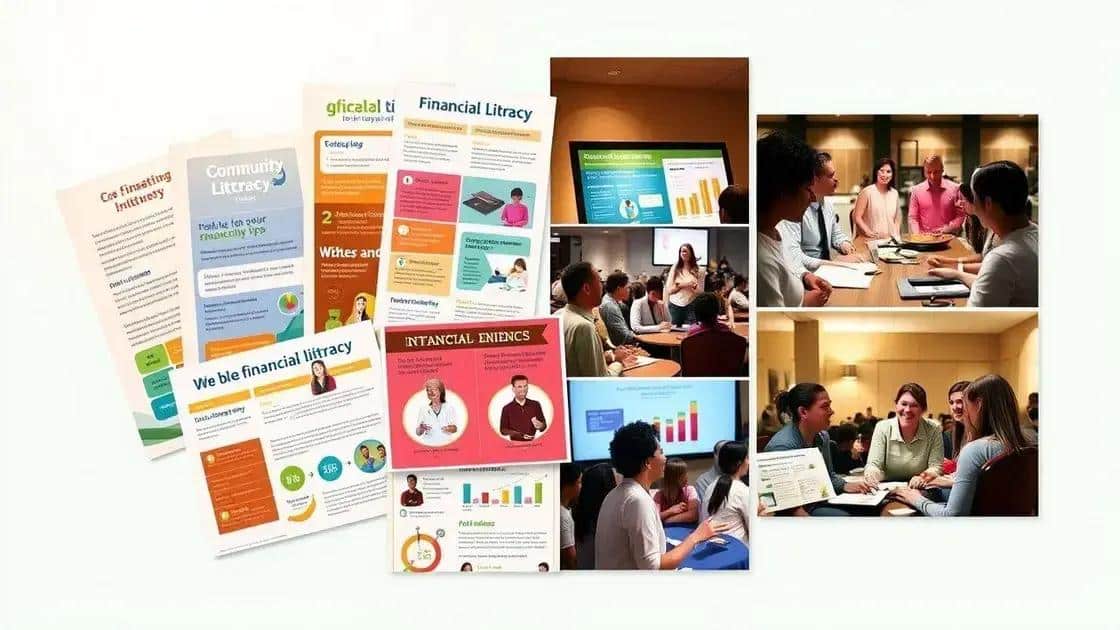Insights on financial literacy campaigns that drive change

Financial literacy campaigns focus on educating individuals about managing money effectively, using engaging methods and technology to enhance understanding while emphasizing the importance of community involvement and cultural relevance.
Insights on financial literacy campaigns reveal how effective these initiatives can be in transforming our relationship with money. Have you ever wondered how these campaigns shape our understanding of finances?
Understanding the importance of financial literacy
Understanding the importance of financial literacy is crucial for individuals and communities. When people have the knowledge to make informed decisions about their money, they can achieve greater financial stability and success.
This knowledge impacts daily life, from managing a budget to planning for retirement. It allows individuals to navigate complex financial systems with confidence, helping them avoid pitfalls such as debt or poor investment choices.
Benefits of Financial Literacy
By enhancing financial literacy, people experience several benefits. These include:
- Improved budgeting skills to manage income effectively.
- Better understanding of credit scores and loans.
- Increased ability to save for emergencies and future goals.
With these skills, individuals are more likely to make sound financial decisions that lead to long-term prosperity.
Community Impact
Financial literacy also strengthens communities. When more people understand how to handle their finances, the entire community benefits. This fosters economic growth and stability.
Moreover, local organizations and schools play a vital role in promoting financial education. Workshops and seminars can reach many individuals, creating an environment where financial discussions are normalized.
As communities prioritize financial literacy, they also see a decline in poverty rates and an increase in prosperity for all citizens. Investing in such educational campaigns fosters a more financially savvy population.
Key elements of successful financial literacy campaigns

Successful financial literacy campaigns share common elements that make them effective. Understanding these elements can help organizations and communities create initiatives that resonate with their audience.
Firstly, clear goals are essential. Campaigns should have specific objectives, such as increasing awareness of budgeting methods or promoting saving habits. By defining what they want to achieve, organizations can tailor their messages more effectively.
Engaging Content
Another key element is the use of engaging content. This means presenting information in a way that is accessible and interesting. Incorporating visual aids, like infographics and videos, can help simplify complex topics.
- Use real-life examples to make the content relatable.
- Incorporate interactive tools such as calculators or quizzes.
- Provide actionable steps that individuals can easily follow.
Additionally, partnerships with local organizations can enhance a campaign’s reach. Collaborating with schools, nonprofits, and community centers allows campaigns to tap into existing networks.
Feedback and Adaptation
Listening to the audience is also vital. Gathering feedback through surveys and social media engagement helps understand what resonates with individuals. This feedback can guide future efforts and adjustments to strategies.
Furthermore, repeated messaging reinforces concepts. A successful campaign often includes multiple touchpoints to ensure the information sticks. Regular follow-ups and reminders can solidify financial concepts in the audience’s minds.
Impact of community engagement in financial education
The impact of community engagement in financial education is profound and far-reaching. When communities come together to promote financial literacy, individuals benefit significantly. Engaged communities create a support system that fosters growth and knowledge.
For instance, local workshops can bridge gaps in understanding. These events allow participants to learn from each other and share their experiences. Participation creates a sense of belonging that encourages individuals to take control of their financial futures.
Benefits of Community Involvement
Having community involvement in financial education leads to several key benefits:
- Stronger support networks for individuals seeking financial guidance.
- Accessibility to resources that may not be available otherwise.
- Opportunities for hands-on learning through practical workshops.
Furthermore, when community organizations collaborate with local schools, they can instill valuable financial habits in children from a young age. Teaching kids about saving, budgeting, and responsible spending helps lay a foundation for their future.
Creating Safe Spaces for Learning
Community engagement also creates a safe space for individuals to discuss their financial struggles. By removing stigma, people feel more comfortable addressing their challenges. This open dialogue is crucial for learning and growth.
Incorporating diverse perspectives enhances the learning experience. Different backgrounds and experiences bring a wealth of information and insights to the table, enriching conversations and encouraging a more comprehensive understanding of financial topics.
Future trends in financial literacy initiatives

Future trends in financial literacy initiatives focus on adapting to the changing needs of society. As technology evolves, so do the methods for teaching financial concepts. Understanding these trends is vital for effective outreach.
One significant trend is the incorporation of digital tools. Many organizations are now using apps and online platforms to engage users. This access allows individuals to learn at their own pace, making financial education more convenient and personalized.
Interactive Learning
Interactive learning experiences are becoming more common. By utilizing gamification, organizations can turn financial education into fun activities. For example, games that simulate budgeting scenarios encourage players to make smart financial choices.
- Apps that track spending can provide personalized advice.
- Online courses offer convenience and flexibility.
- Webinars connect experts with large audiences for real-time learning.
Moreover, microlearning is gaining traction. This approach breaks down complex topics into bite-sized lessons. Instead of overwhelming learners with too much information at once, microlearning helps individuals absorb what they need to know more effectively.
Community-Centered Approaches
Future initiatives will likely emphasize the importance of community involvement. By focusing on local needs, financial literacy programs can become more relevant. Organizations may collaborate with schools, banks, and nonprofits to create tailored resources.
Additionally, there is a growing recognition of the importance of cultural relevance in financial education. Programs that understand and respect the diverse backgrounds of their audiences build trust and effectiveness. This focus will help ensure that all communities have access to valuable resources.
FAQ – Frequently Asked Questions about Financial Literacy Initiatives
What is financial literacy and why is it important?
Financial literacy is the ability to understand and manage personal finances, helping individuals make informed decisions about saving, investing, and spending.
How can technology enhance financial literacy campaigns?
Technology, such as apps and online platforms, makes learning about finances more accessible and engaging through interactive tools and resources.
Why is community engagement crucial for financial education?
Community engagement creates relevant and supportive environments, allowing individuals to learn from shared experiences and local resources.
What role does cultural relevance play in financial literacy initiatives?
Cultural relevance ensures that financial education materials resonate with diverse audiences, building trust and increasing the effectiveness of programs.






